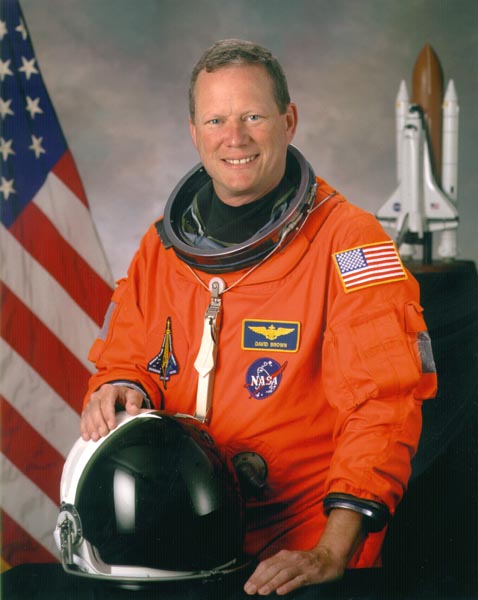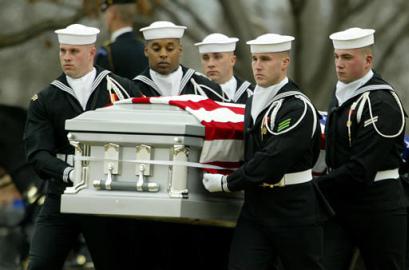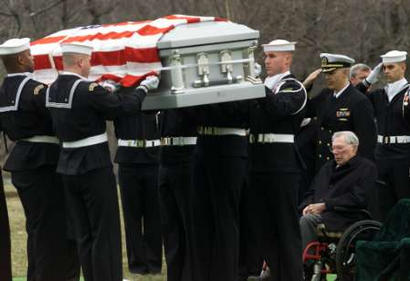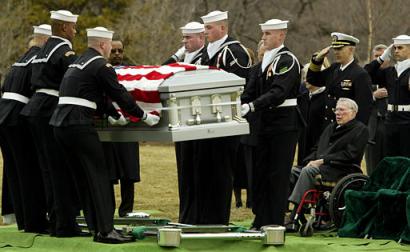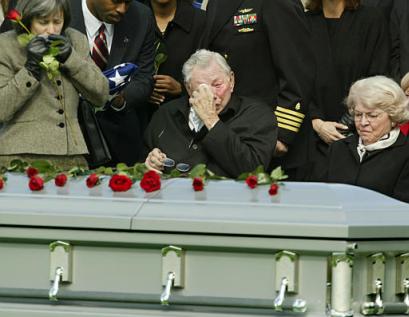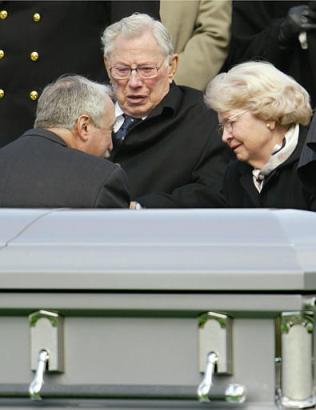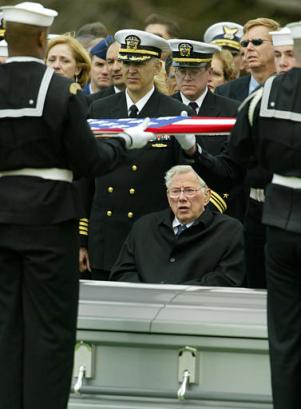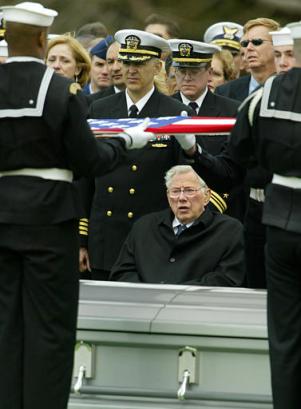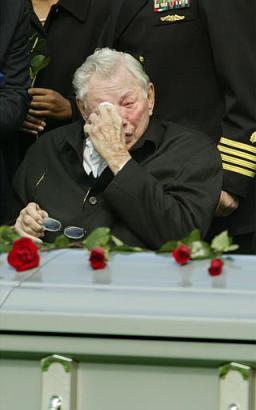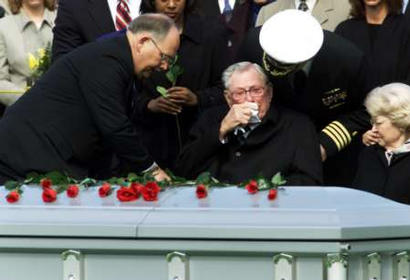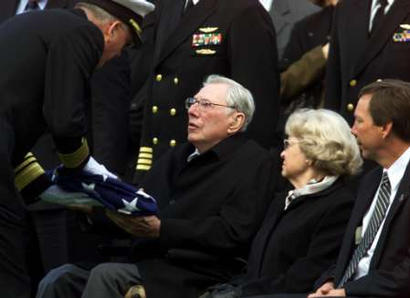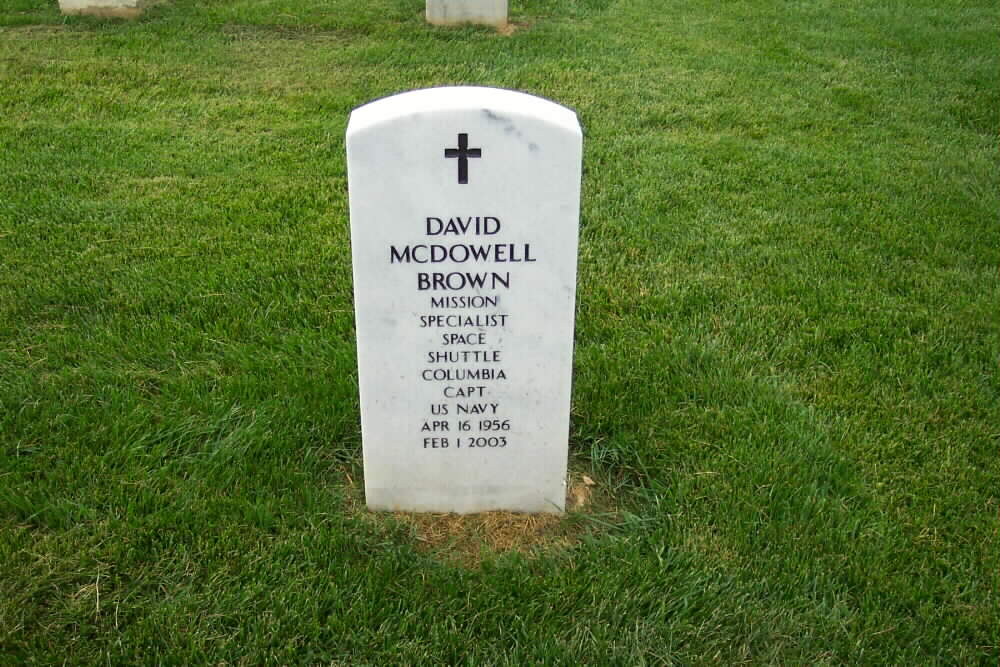Shuttle Columbia Memorial Dedicated: 3 February 2004
Shuttle astronaut David Brown once took a car engine apart and put it back together because he just wanted to see how it worked.
When a Hartford, Connecticut, astronomy teacher asked for a signed photograph for class, Brown declined to send it, choosing instead to become a mentor to many of those students.
Brown had a thirst for life and its offerings, friends say, and was many other things, too: a Navy Captain and pilot, a flight surgeon, a gymnast, a circus performer, a bike rider and a budding filmmaker.
On Wednesday, Brown became the 19th astronaut laid to rest at Arlington National Cemetery, one of the seven killed in the February 1, 2003, breakup of space shuttle Columbia.
The space flight was Brown’s first.
Retired Navy Lieutenant Commander Jeff Goldfinger recalled Brown’s invitation to a NASA family barbecue days before the shuttle’s Jan. 16 launch. But Goldfinger didn’t seem to know why he was asked, telling some 300 mourners at a nearby military chapel that he was no closer to Brown than they were.
With Brown, however, “It was never about Dave. It was always about what he could do for somebody else,” said Goldfinger, who told the story about the Connecticut schoolteacher.
“He was the most humble overachiever we’ve all ever known,” Goldfinger said.
Brown, 46, was a Navy Captain, pilot and flight surgeon. He joined the Navy after a medical internship, then went on to fly the A-6E Intruder and F-18. He became an astronaut in 1996.
Brown was a gymnast in high school and college, and once spent a summer working for a traveling circus, where he did acrobatic stunts, walked on stilts and rode a 7-foot unicycle.
“A very human being,” said medical school classmate Gordon Iiams, a retired Navy Captain. “He was so bubbly with enthusiasm,” and a “sheer joy or life and all its trimmings.”
Sunny, blue skies turned gray Wednesday after the half-hour memorial service. Mourners streamed from the chapel and lined up for the half-mile walk to the burial site.
Brown will rest alongside Columbia crew mates Laurel Clark, whose funeral was here Monday, and Michael P. Anderson, buried last Friday. Brown is the last of the Columbia seven to be buried.
The three will rest just steps away from where the Challenger astronauts are remembered with a granite memorial. The shuttle Challenger exploded just after blasting off in January 1986.
The burial, with full military honors, was a homecoming of sorts for Brown, who grew up in Arlington County and attended high school here.
The graveside service began with a “missing man” formation flyover, in which one of four F-18 jets that roared overhead peeled away, soaring into the sky and out of sight.
An honor guard and military band accompanied the silver coffin, draped with an American flag, as it was drawn across the cemetery grounds on a caisson pulled by a matched set of six horses. A squad fired three rifle volleys and a lone bugler played “Taps.”
The flag was folded and handed to Brown’s father, Paul, who was pushed forward in his wheelchair to lay a red rose on his son’s coffin. He removed his eyeglasses and wiped away tears.
Other immediate family, including his mother Dorothy, brother Doug, niece Casey, nephew Paul and former sister-in-law Diane, also laid single roses atop the coffin.
Courtesy of the Washington Post:
A Joy That Defies His Absence
Alexandria Astronaut Mourned With Tales of Passion, Tears of Laughter
By Timothy Dwyer
Washington Post Staff Writer
Thursday, March 13, 2003
There is a single word that Dave Brown’s friends used to describe him, a simple word, one that comes up again and again when they talk about what kind of person he was.
Present.
Navy Captain David M. Brown, 46, a native of Alexandria and explorer of earth and space, was buried yesterday at Arlington National Cemetery, the last member of the shuttle Columbia crew to be laid to rest.
At a memorial service before the graveside ceremony, Brown’s presence was fully felt during three eulogies that left many of the hundreds who gathered to say farewell with tears of laughter in their eyes.
His father, retired Arlington County Circuit judge Paul D. Brown, and mother, Dorothy, sat in the front of the Memorial Chapel at Fort Myer and listened to story after story about their son, stories of his generosity, endless enthusiasm, passion and loyalty.
Retired U.S. Navy Lieutenant Commander Jeff Goldfinger was the first to speak. “I wrote up a half-hour-long speech,” he said, laughing as he held up several sheets of paper. “And the judge said , ‘No, it has to be five minutes.'”
Then he wondered out loud how in the world anyone could talk about Dave Brown for just five minutes.
The atmosphere was less like a solemn funeral than an old-time Irish wake. Brown, a mission specialist on the Columbia mission that ended in tragedy February 1, 2003,touched many people in his life as a gymnast, doctor, flight surgeon, test pilot, astronaut, budding cinematographer, friend, brother and son.
The service was a celebration of his life, many stories told quickly, but not quickly enough to fit into their few allotted minutes.
Retired Navy Captain Gordon Iiams, the second speaker, was asked later what his friend Dave Brown would have thought of the memorial service.
Iiams, a classmate of Brown’s at Eastern Virginia Medical School, laughed and said: “Too somber. He liked things to be upbeat and positive.”
When the memorial service ended, Brown’s silver coffin was placed on a horse-drawn caisson and hundreds of his friends, family and colleagues walked slowly behind from the chapel to the grave that had been opened beside those of two of his six fellow crew members, Air Force Lieuenant Colonel Michael Anderson and Navy flight surgeon Laurel B. Clark.
His father, who uses a wheelchair, led the procession. As the horses drawing the caisson took their first steps toward the cemetery, he took off his glasses and dabbed at his eyes with a handkerchief.
Brown was buried with full military honors. Four U.S. Marine F-18s roared overhead as six sailors removed his flag-draped coffin from the caisson.
Brown decided to join the Navy while he was an intern at the Medical University of South Carolina and he came across a brochure showing a Navy physician standing on a flight deck next to an F-4 Phantom fighter jet. He thought it looked cool.
In the Navy, he was the first flight surgeon in 10 years to be selected for pilot training and finished first in his class. He had fallen in love with flying as a boy when a family friend took him for a ride in an airplane. He got his pilot’s license while a student at the College of William and Mary. And once the Navy let him fly, it was difficult to keep him on the ground.
He flew more than 2,700 hours, more than half of that time in high-performance jets. He was carrier-qualified and selected as a test pilot, assigned to the Naval Warfare Center in Fallon, Nevada, where only the best pilots are sent.
Throughout his life, friends recalled yesterday, Brown’s humility seemed to grow with each goal he achieved.
“Two days before the [Columbia] launch,” Goldfinger said, “Dave invited me to attend the NASA family barbeque. I was no closer to Dave than anyone else in here today. But the reason he asked me is that he knew I would get the most out of it. That was what Dave was all about. It was never about him.”
He recalled that Brown had applied to be a NASA astronaut a couple of years before he was accepted in the class of 1996, but was turned down.
Yesterday, after the bugler played taps and a Navy band played “America the Beautiful,” Brown’s father was presented with the flag that had covered the coffin. He took the flag, dabbed his eyes once again and placed a rose on the coffin.
Friends and family followed, including Jon Clark, who buried his wife, Laurel, at the same spot on Monday. Then Clark knelt near the flowers at his wife’s grave and bowed his head. After a moment, he stood, tears in his eyes, and walked away.
The other four members of the Columbia crew — Navy aviator William C. McCool, Air Force Col. Rick D. Husband and mission specialists Kalpana Chawla and Ilan Ramon — were laid to rest elsewhere.
“All seven of those folks on that space craft, that shuttle, were wonderful people,” Iiams said as he left Brown’s grave yesterday. “They were all like Dave.”
DAVID M. BROWN (CAPTAIN, USN)
NASA ASTRONAUT
PERSONAL DATA: Born April 16, 1956 in Arlington, Virginia. Single. Died on February 1, 2003 over the southern United States when Space Shuttle Columbia and her crew perished during entry, 16 minutes prior to scheduled landing. He is survived by his parents, Paul and Dorothy Brown. David enjoyed flying and bicycle touring. He was a four year collegiate varsity gymnast. While in college he performed in the Circus Kingdom as an acrobat, 7 foot unicyclist and stilt walker.
EDUCATION: Graduated from Yorktown High School, Arlington, Virginia, in 1974; received bachelor of science degree in biology from the College of William and Mary in 1978 and a doctorate in medicine from Eastern Virginia Medical School in 1982.
ORGANIZATIONS: Past President, International Association of Military Flight Surgeon Pilots. Associate Fellow, Aerospace Medical Association. Society of U.S. Naval Flight Surgeons.
SPECIAL HONORS: Navy Operational Flight Surgeon of the Year in 1986, Meritorious Service Medal, Navy Achievement Medal.
EXPERIENCE: Brown joined the Navy after his internship at the Medical University of South Carolina. Upon completion of flight surgeon training in 1984, he reported to the Navy Branch Hospital in Adak, Alaska, as Director of Medical Services. He was then assigned to Carrier Airwing Fifteen which deployed aboard the USS Carl Vinson in the western Pacific. In 1988, he was the only flight surgeon in a ten year period to be chosen for pilot training. He was ultimately designated a naval aviator in 1990 in Beeville, Texas, ranking number one in his class. Brown was then sent for training and carrier qualification in the A-6E Intruder. In 1991 he reported to the Naval Strike Warfare Center in Fallon, Nevada, where he served as a Strike Leader Attack Training Syllabus Instructor and a Contingency Cell Planning Officer. Additionally, he was qualified in the F-18 Hornet and deployed from Japan in 1992 aboard the USS Independence flying the A-6E with VA-115. In 1995, he reported to the U.S. Naval Test Pilot School as their flight surgeon where he also flew the T-38 Talon.
Brown has logged over 2,700 flight hours with 1,700 in high performance military aircraft. He is qualified as first pilot in NASA T-38 aircraft.
NASA EXPERIENCE: Selected by NASA in April 1996, Brown reported to the Johnson Space Center in August 1996. Having completed two years of training and evaluation, he is eligible for flight assignment as a mission specialist. He was initially assigned to support payload development for the International Space Station, followed by the astronaut support team responsible for orbiter cockpit setup, crew strap-in, and landing recovery. Dave Brown flew aboard STS-107 and logged 15 days, 22 hours, and 20 minutes in space.
STS-107 Columbia (January 16 to February 1, 2003). The 16-day flight was a dedicated science and research mission. Working 24 hours a day, in two alternating shifts, the crew successfully conducted approximately 80 experiments. The STS-107 mission ended abruptly on February 1, 2003 when Space Shuttle Columbia and her crew perished during entry, 16 minutes before scheduled landing.
Captain Brown will be laid to rest in Arlington National Cemetery on 12 March 2003, at 1245 hours.
David M. Brown, 46, a captain in the U.S. Navy, was a naval aviator and flight surgeon. He served as Mission Specialist 1 for STS-107.
Brown received a bachelor of science in biology from the College of William and Mary in 1978 and a doctorate in medicine from Eastern Virginia Medical School in 1982.
Brown, as a member of the Blue Team, worked with the following experiments: European Space Agency Advanced Respiratory Monitoring System (ARMS); Combustion Module (CM-2), which included the Laminar Soot Processes (LSP), Water Mist Fire Suppression (MIST) and Structures of Flame Balls at Low Lewis-number (SOFBALL) experiments; Mediterranean Israeli Dust Experiment (MEIDEX); and the Physiology and Biochemistry Team (PhAB4) suite of experiments, which included Calcium Kinetics, Latent Virus Shedding, Protein Turnover and Renal Stone Risk.
Selected by NASA in April 1996, Brown was making his first spaceflight.
Astronaut’s cousin praises his courage
Thursday, February 27, 2003
David Brown was a circus performer, gymnast, Navy pilot and photographer. He also was an astronaut aboard the space shuttle Columbia when fell apart while returning to Earth on February 1, 2003
“His humbleness and his modesty were his most outstanding characteristics,” said Cindy Jacobson, Brown’s cousin, who lives in Rockford. “He came back for a circus reunion, and for the longest time he didn’t even tell them he was an astronaut.”
She spoke to students about courage at Knapp Charter Academy in Grand Rapids on Friday. After the speech, Jacobson said her cousin became interested in flying after seeing the movie “Top Gun.”
“He was going to medical school when he went to see ‘Top Gun’ with some friends in San Francisco. When he saw it, he said, ‘I want to do that,’ ” he said.
Jacobson attended the launch of the Columbia in Florida and will attend Brown’s funeral at Arlington National Cemetery this week. Her mother and Brown’s mother are sisters.
“The last time I saw him was before he got into NASA (in 1996), but we were looking forward to getting his perspective on space when he had some time,” she said.
Jacobson said Brown performed as a gymnast during college, riding a 7-foot-tall unicycle and performing other tricks.
“They had the neatest circus. It was called the Kingdom Circus and they worked to promote peace, brotherhood and faith,” Jacobson said.
She said Brown also enjoyed photography and documented many of Columbia’s exploits on film.
In his last e-mail message to friends, Brown wrote: “The views of the Earth are really beautiful. If you’ve ever seen a space IMAX movie, that’s what it really looks like.”
BROWN, DAVID MCDOWELL
- CAPT US NAVY
- DATE OF BIRTH: 04/16/1956
- DATE OF DEATH: 02/01/2003
- BURIED AT: SECTION 46 SITE 1180-3
ARLINGTON NATIONAL CEMETERY
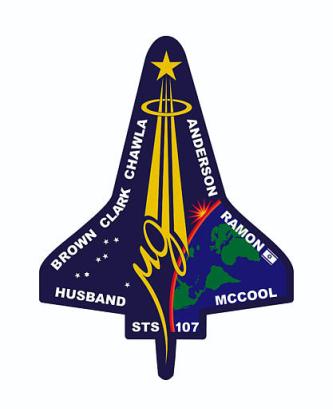
The flag-draped casket of space shuttle Columbia mission specialist, Navy Captain David M. Brown, is carried to the graveside funeral service with full military honors at Arlington National Cemetery, Wednesday, March 12, 2003.
Paul Brown (lower right) watches his son’s, Navy Captain David M. Brown, coffin at Arlington National Cemetery, March 12, 2003.
As his father Paul Brown watches from his wheelchair at right, space shuttle Columbia mission specialist, Navy Captain David M. Brown, is buried with full military honors at Arlington National Cemetery in Arlington, Virginia, his home town, Wednesday, March 12, 2003.
As his father Paul Brown weeps, center, Space shuttle Columbia mission specialist, Navy Captain David M. Brown, is buried with full military honors at Arlington National Cemetery, in Arlington, Virginia, his home town, Wednesday, March 12, 2003. His mother Dorothy Brown mourns at right.
NASA Administrator Sean O’Keefe, left, bends down to comfort the parents of space shuttle Columbia mission specialist Navy Captain David M. Brown, as the fallen astronaut is buried with full military honors at Arlington National Cemetery.
As his father Paul Brown watches from his wheelchair at center, space shuttle Columbia mission specialist, Navy Captain David M. Brown, is buried with full military honors at Arlington National Cemetery, Wednesday, March 12, 2003. Dr. Jonathan Clark, the husband of Captain Laurel Blair Salton Clark, is at right in sunglasses.
As his father Paul Brown watches from his wheelchair at center, space shuttle Columbia mission specialist, Navy Captain David M. Brown, is buried with full military honors at Arlington National Cemetery,Wednesday, March 12, 2003.
As his father Paul Brown weeps, space shuttle Columbia mission specialist, Navy Captain David M. Brown, is buried with full military honors at Arlington National Cemetery, Wednesday, March 12, 2003.
Paul Brown is comforted at his son’s, Navy Captain David M. Brown, grave site at Arlington National Cemetery, March 12, 2003.
Paul Brown is handed the flag from his son’s, Navy Captain David M. Brown, coffin at Arlington National Cemetery, March 12, 2003.
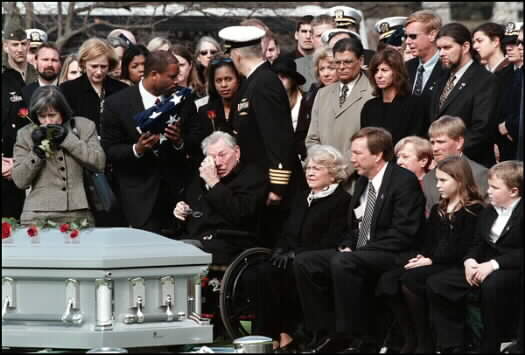
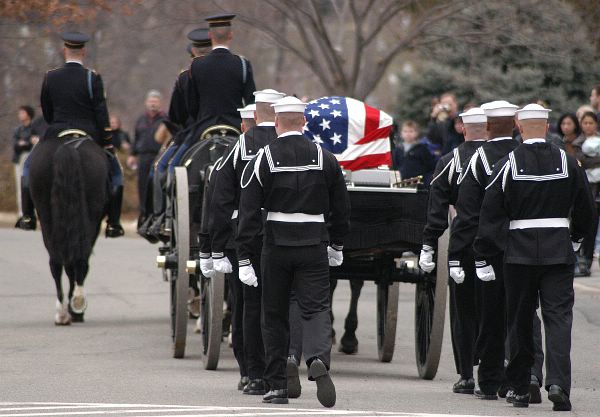
Michael Robert Patterson was born in Arlington and is the son of a former officer of the US Army. So it was no wonder that sooner or later his interests drew him to American history and especially to American military history. Many of his articles can be found on renowned portals like the New York Times, Washingtonpost or Wikipedia.
Reviewed by: Michael Howard


